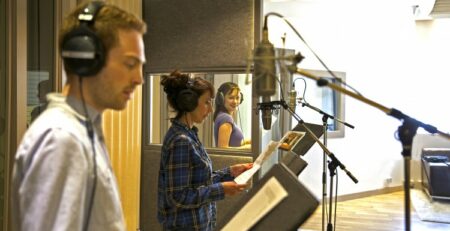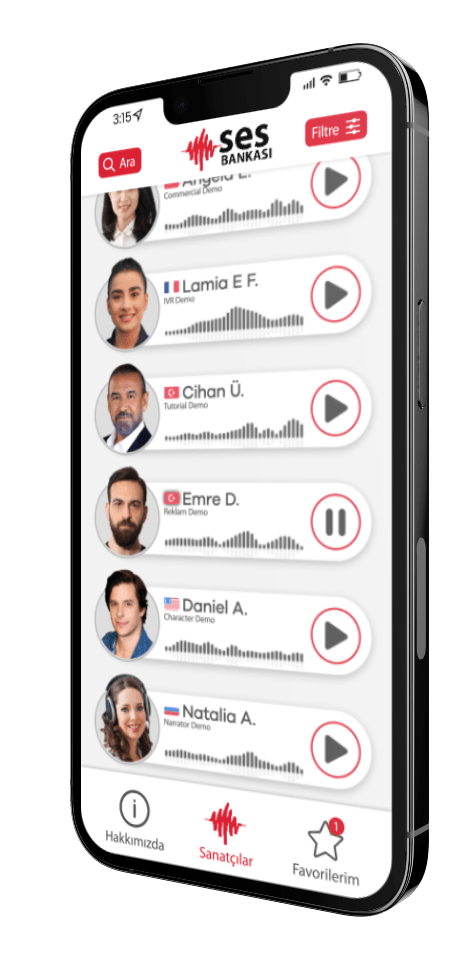Sound Protection Techniques, Exercises and Correct Breathing Techniques: Voice Health for Voice Actors
Correct posture and microphone techniques when recording audio Using it effectively ensures successful recordings. At the same time, voice actors do some sound preservation techniques to protect their vocal health. Because it is important to protect the sound health as much as knowing the equipment and methods needed for technical vocalization. For this reason, it is extremely important that artists who are professionally interested in the art of voice acting take care of their voice. When it comes to vocal health, simple measures such as keeping your vocal cords healthy, avoiding shouting, and avoiding tension by speaking softly may not be enough. For voice actors, the sound must always be ready for use and taken care of.
voice actorsLifestyle changes are the basis of the methods that can be applied to protect voice health. Regular audio listening practice, diet and regular vocal exercises This is one of the most fundamental changes.
The routine habits of voice actors in daily life without realizing it may be damaging the vocal cords. It is extremely important to protect the voice and control the habits, especially in some voice-over projects. To give an example, everything that a voice actor who goes to the microphone for an audiobook or animated movie eats and drinks throughout the project directly affects the sound recording.
So, what are the sound protection techniques? What exercises and techniques should voice actors apply to maintain their voice? We have compiled the answers to the frequently asked questions for you in this article.
Voice Health Basics: What Can I Do to Protect My Voice?
Voice health focuses on what voice actors should do to keep both their speaking voice and their voice acting free from overuse, infections, and other issues. At this stage, voice therapy and voice exercises are one of the basic practices that a voice actor can do to maintain voice health.. In order to protect the sound health, it is necessary to know the working principle of the sound well before these applications. Sound, which is a form of energy that moves from the vibrating source, creates pressure changes that the ear can detect. Its working principle is that mechanical vibrations, which occur through an agent in an elastic environment, propagate in waves and provide hearing sensation.
It is useful to look at certain points to understand whether a voice is healthy or to decide whether it is a problem that should be taken seriously. In particular, factors such as diet, daily vocalization time, vocal warm-ups and general body health give important clues about your voice health. When you have a healthy voice, in addition to a smooth voice, you can talk in the desired time, enter the desired character easily, and continue the voice amplification processes without any problems.. You may need to review the health of your voice when you are unable to provide good breathing support and optimize voice production strategies in warm-up exercises before using the voice.
Vocal Cords Structure and Working Principles
The vocal cords consist of two ligaments located in the larynx called the larynx. The vocal cords, known as the two layers of mucous membranes in the laryngeal cavity, are the main organs responsible for voice production. The vocal cords are basically folds of throat tissues that are key in creating a sound through vocalization. Vibration occurs in these folds in response to the air passing through the cartilages in the larynx suspended in the neck. Thanks to the vibration created, actions such as speaking, singing and other vocal sounds take place.
The vocal cords have a structure that opens when breathing and vibrates when speaking or singing. This part, called the vocal folds or vocal cords laryngeal repeating the branch vagus controlled by the nerve. A column of air pressure moves towards the vocal cords during the formation process of the sound. At this stage, the air moves from the lungs to the vocal cords, acting in a coordinated manner from the diaphragm, abdominal muscles, pectoral muscles, and rib cage. While exhaling, the air coming from the lungs vibrates with the vocal cords in the larynx, creating sound.
Causes of Voice Disorders
Many people, especially professionals and musicians who have been dealing with the art of voice acting for a long time, may encounter sound disorders. Sound disorders, especially caused by intense and long-term use of sound, can bring along different factors. Generally hoarseness, vocal cord paralysis, vocal cord nodule and vocal cord polyp are among the most common disorders. In addition, it causes short-term discomfort in the voice hoarseness There is also such a problem. So, what are the causes of voice disorders? Here is the answer…
- Swelling and inflammation of the vocal cords
- Incorrect and excessive use of voice
- prolonged shouting
- thyroid problems
- Allergy and age factors
- Throat dehydration smoking
Important Tips for Healthy Voice Use
People who need sound use in a healthy way should organize their daily life in accordance with the soundness of the voice. It is also important for those who are professionally involved in voice and dubbing to include voice function exercises in their routine. Here are tips for using a healthy voice:
- To ensure proper lubrication, as the vocal cords vibrate very quickly. You should drink plenty of water.
- Your voice can get tired easily in long-term voiceover projects. In order to prevent this, it will be healthier to take a break for a few days in long-term projects.
- Cigarette smoke and its content affect many organs that are effective in the formation of voice, especially the larynx. SIn order to use your wife in a healthy way, it is useful to avoid smoking.
- During periods when the throat is dry or tired, actions such as shouting and talking loudly can damage the voice. Reduce voice use to reduce vocal cord irritation.
- To make better use of airflow and breathing You can start the day with lip and tongue trembling movements.
- Instead of intense warm-up exercises for a healthy sound start with simple movements.
- directly affecting your voice Do not neglect to exercise to reduce muscle tension in the neck, shoulders and jaw.
Sound Exercises and Correct Breathing Techniques
The health of the voice is very important for people who are professionally interested in dubbing and voiceover art. Thanks to vocal exercises and correct breathing techniques, it becomes possible to combine vocal skills with perfect work. In a healthy voice and breathing exercise; it is necessary to focus on phases such as alignment and body work, breath support, resonance and sound release, and articulation. Dcorrect breathing techniquesIndividuals who incorporate the digital language into their daily life can experience their contribution to voice and speech by achieving effective results in a short time. Sound protection techniquesYou can complete the steps for a healthy voice by including the .
The Importance of Voice Exercises How to Do Voice Exercises
When it comes to voice exercises for people working in the field of voice-over and dubbing, it is necessary to pay attention to certain practices. It is extremely useful for professional people to be ready for the project they will voice and to get help from voice exercises for the transition process. In addition, thanks to the sound exercise, which offers the advantage of preliminary preparation, people can start the main project in a much more prepared way.
Here are the most preferred vocal exercises…
- Relaxing Muscles: Pronunciation and expression of words are extremely important in the vocalization phase. Artists who use the lips, teeth, tongue and palate to convey the dialogue clearly need to exercise beforehand. You can get help from the power of words to relax the muscles that will be used before performing. One of the most common words "ohRepeat the word 'with a deep breath.
- Rhymes: Rhymes, which take up a lot of space in daily life, are one of the important exercises for vocal studies. It is possible to prepare much better for the vocalization project by means of rhymes that allow the artists to take control in the mouth. You can use the following rhymes while doing voice exercises;
“You can believe the word of vegetable growers from Samsun, who say that only onions and garlic can grow in the thirsty reeds of Sason, silently and by taking shelter in your intuition.”
“I don't know whether it is better the oysters of the hoarder Ibiş from Istinye to improve the hoopoes, or the yarn of the finch hawker Ishak from Iskilip, which is better.”
“Midwife Ecel, decent Efe sovereign, added her dragon license in education and made her hands memorize the scheming speculator male dark-haired wife of the retiree, saying 'Wait,' in her house with a shelf.”
- Volume Up and Down: In voiceover projects, there may be moments when the sound suddenly goes up or down. To make the most of the sound and to reflect the dialogue, it is necessary to use the sound well. You can prepare your voice for the project with the raising and lowering exercise. For this, you can make an “A” sound by slowly raising and lowering the volume.
Breathing Techniques and Importance of Correct Breathing
breathing techniques focuses on breathing correctly and the correct use of voice while vocalizing. The voice actor must breathe correctly in order to read the text placed in front of him in the best way and without interruption. At certain moments, there may be situations where the sound cannot capture the correct tone and emphasis. With the right breathing techniques, you can eliminate the problems by preventing vocalization. Here are the breathing techniques that can be applied for vocalization exercises:
- Inhale and Exhale: To practice this technique, the feet should be shoulder-width apart, the chest out and the spine straight. Then, inhale through your nose and lift your shoulders. At this stage, exhale through your mouth, feeling your stomach expand. At the same time as you exhale, the shoulders should come down and pull up again to repeat the movement. Performers should focus on getting more air into the lungs each time doing this exercise.
- Breathing Exercise with Consonants: Hard consonants in Turkish are one of the simple but effective movements in breathing techniques. For this “ff”, “sh” and “ss” You can gently warm up your vocal cords and do breathing exercises by making sounds. First, take a deep breath and as you exhale, "ff" raise your voice. Next "sh" and "ss" You can continue for three rounds by making the same sounds. Depending on your lung capacity and the state of your voice, the duration of this exercise may vary. Thanks to this exercise done regularly, you can make these sounds longer without breathing.
- Breathing Exercise with Vowels and Consonants: In the other step of the breathing exercises, you can breathe by putting a consonant in front of the vowels. for this slowly “uh”, “ah”, “oh”, “oo”, “ee” Relax your voice by removing the attachments. Start softly as you complete each insert in three rounds and continue to increase the volume a little each round. Remember that the goal here is to regulate the breathing and make the sound comfortable.
Techniques for Controlling the Pitch and Pitch of the Voice
pitch and tone of voice is one of the most important concepts for professional voice actors. Considering that everyone's voice color is unique, it is considered extremely normal to have different voice tones. Although the tones of voice differ according to the gender factor and the color of the voice, the training of the voice comes into play during the application. Some roughness may occur in voice-overs with an untrained voice. You can try solutions that eliminate problems with tone and pitch by focusing on volume control.
Here are techniques that will allow you to control the tone and pitch of your voice:
- Pitch Changing Practice: Voice actors can develop the muscles around the vocal cords by changing the pitch. The increase and decrease of the pitch contributes to the strengthening of the different muscles in the larynx by relaxing and contracting them. Thanks to the aforementioned pitch changing exercise, voice actors can adapt more easily while producing sounds of different pitch and thickness. In order to change the pitch of the voice, methods such as lowering the voice, speaking with a different expression and reading the text by humming can be preferred.
- Variation of Vocal Pitch: You can create rising and falling pitches instead of a monotonous expression. For this, you can finish the questions in a higher pitch and the statements in a lower pitch in the text exercises.
- Diaphragmatic Breathing for Tone: Breathing from the diaphragm is extremely important to optimally control the tone of voice. To practice this, place your hand on your stomach and use your diaphragm to push it out as you breathe in.
- Usage of Lip, Jaw and Tongue: The position of the chin directly affects the output of sounds from the mouth and tone of voice. Trying to speak with the jaw open an inch or two is an effective way to get a clean and accurate sound. In order for the jaw, lips and tongue to contribute to the vocalization in the best way, you can try the technique of reading aloud by holding a pencil between your teeth.
We include female and male voice tones, The importance of voice color and tone in vocalization You can find detailed information about tones by browsing our content.
Common Problems and Solutions for Voice Over Artists
Professional voice actors may encounter various sound problems after long and hard work. Although the problems caused by voice fatigue and swelling in the larynx are resolved in a short time, they can cause different problems in the long run. What are the sound problems that are frequently seen in voice actors, let's see together!
Problems such as Muffled, Hoarseness, Module
Voice actors can perform voiceovers consisting of different trials for the same text and project for a long time. After such long-term studies, many artists voice disorders may encounter. Vocal cords that get tired especially before and during recording can cause swelling in the larynx and cause hoarseness. One of the voice disorders frequently seen in professional voice actors is vocal cord nodules. Vocal cord nodules are benign growths that occur on the free surface where the vocal cords come into contact with each other. This disorder, which should not be confused with cancer, can be seen in many professional voice actors. This situation mostly develops when the voice is used for a long time, at wrong volume, wrong pitch and inappropriately forcing.
Speech Therapy and Other Treatment Options to Correct Diction
Having a good diction allows people to connect with their work in many fields, especially in voice acting. In some cases, the diction that facilitates the connection with the listener and increases the effect may need correction. It is of particular importance that the diction be fluent and smooth for those who are considering doing professional voiceovers. For this reason, people who say they want to be a voice actor should first focus on diction correction.
At the beginning of the best treatment options that can be done to correct diction practicing nursery rhymes and reading aloud. In another step face yoga like treatment options that focus on strengthening the facial muscles Activated. In this way, people can prevent diction problems caused by weakness in the facial muscles. Another method that can be followed to correct diction is recognizing the speed of sound and eliminating exaggerated mouth movements. For this, you can do diction exercises in front of the mirror.
If you want to take part in the voice-over industry, I want to be a voice actor Check out our article.
The Effect of a Healthy Lifestyle on Voice Health
Vocal cord can be easily influenced by many habits and intensity in daily life. Your voice health may encounter various problems due to factors such as prolonged speech, forcing and high pitched speech. People who are professionally interested in the art of vocalization need to take some steps regularly to protect their voice health.
So, what practices should you do and what should you stay away from for a healthy voice?
- Meeting your daily water needs adequately prevent irritation of the throat.
- While eating healthy and regular limit alcohol use.
- During long-term vocalization periods Go for decaffeinated fluids.
- To maintain vocal health, the head should be kept above the level of the stomach. Therefore, adjust your sleeping posture by raising the head of the bed.
- Having healthy lungs is also having a clean and balanced voice. Therefore, incorporate movements such as regular walking, yoga and meditation into your daily activities.
- Maintaining lung health is as important as eating healthy food for your voice. By ending smoking, you can accompany voice-over projects for a longer period of time in a healthy way.
- To avoid causing problems with the vocal cords, excessive shouting and Avoid activities such as talking loudly.
If you are interested in the field of voiceover and dubbing, you can understand which field of voice your voice is suitable for by having a Voice Analysis. Audio Analysis, It is made individually by the expert team of BiberSA Production.






















